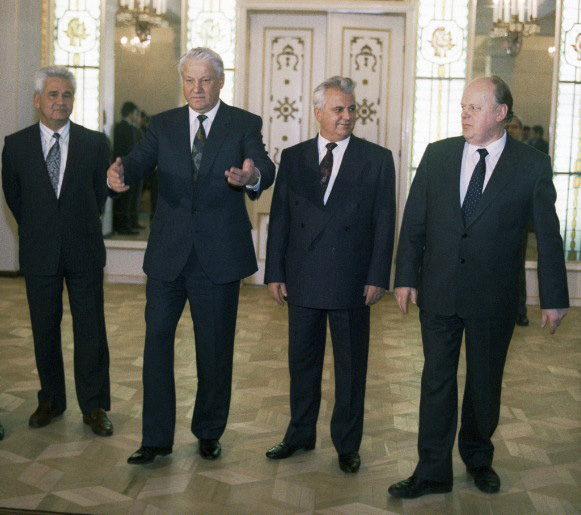Belavezha Agreement
Belavezha Agreement. An agreement signed by the leaders of Belarus, the Russian Federation, and Ukraine in December 1991, which terminated the existence of the Union of Soviet Socialist Republics (USSR), created the Commonwealth of Independent States (CIS), and ended the career of USSR President Mikhail Gorbachev. Meeting in Belavezhaia Pushcha in the forests of Western Belarus to resolve a stalemate on the Soviet Union’s reconfiguration, the Chairman of the Supreme Soviet of the Belorussian SSR, Stanislau Shushkevich, the President of the Russian Soviet Federated Socialist Republic, Boris Yeltsin, and the newly-elected President of Ukraine, Leonid Kravchuk, signed three historic documents. One declared the formation of the CIS stating its membership was open to all republics of the Soviet Union; the second was an agreement on the new CIS structure’s principles and spheres of common activity; and the third was a statement on the coordination of their economic policy.
The Agreement revoked the Union Treaty of 1922, to which the three parties claimed to have been signatories, stating ‘that the USSR as a subject of international law and a geopolitical reality, is ceasing to exist.’ It declared that consequently the three signatories were ‘forming the Commonwealth of Independent States.’ They would henceforth develop cooperative relations, respect each other’s territorial integrity and inviolability of borders, work towards peace and security, operate jointly through common institutions in specific spheres of activity, and no longer allow the operation of USSR laws on their territory. This was a compromise between full union and complete independence for the republics of the former Soviet Union; as such, it could not satisfy all the parties involved.
The secret meeting of the three leaders was the culmination of a prolonged effort by Mikhail Gorbachev to reform in line with his policy of perestroika the overly centralized USSR without allowing its complete disintegration. A draft of a new Union Treaty had appeared in November 1990, and a referendum was held on it on 17 March 1991 in which only nine of the sixteen republics took part. It passed, but strong opposition, chiefly from Boris Yeltsin, impelled Gorbachev to hold a meeting with the nine in April in Novo Ogarevo in search of a more acceptable compromise version. A major point of contention was Gorbachev’s insistence on the new Union being a confederate state (a supranational state), while Yeltsin and Ukraine insisted it be a confederation (similar to the European Union) instead. Unless it were a state, Gorbachev threatened to resign; Yeltsin wanted it to be merely a coordinating body with a decorative president. Signing of the new treaty was scheduled for 20 August, but this was overturned by the abortive coup against Gorbachev by the ill-fated and short-lived Committee for the State of Emergency. After the coup was thwarted, all republics except the RSFSR and Kazakh SSR adopted declarations of independence and power was effectively transferred to the republics. Another new draft was to have been considered at the end of November, but was rendered obsolete by the results of Ukraine’s referendum on 1 December 1991, which approved unequivocally Ukraine’s independence and in the course of the campaign for which President Kravchuk stated clearly that he would not sign the Union Treaty.
The Belavezha Agreement put an end to the Union Treaty but itself came immediately under strain as a practical replacement for the USSR, not least by the actions of Ukraine and the Russian Federation. The three Slav republics quickly ratified it, denouncing the 1922 Union Treaty. The Supreme Council of Ukraine, however, made significant amendments weakening its provisions for cooperation while guaranteeing Ukraine’s territorial integrity should it cease to be a member of the CIS. It was viewed as a transitional rather than permanent device, pending the country’s economic recovery and assured security. Nor was the CIS, for Ukraine, a state structure and subject of international law, its decisions being merely recommendations to member states. Any notion of the CIS’s coordinating bodies becoming governing structures was anathema to Ukraine. President Leonid Kravchuk, furthermore, issued decrees creating Ukraine’s own armed forces by taking over the Soviet troops and equipment on its territory with himself as commander-in-chief. This eliminated the possibility of being controlled militarily by the CIS. The Russian Federation antagonized the other republics by its fiscal policies as well as by unilaterally seizing all assets of the USSR including embassies abroad without compensation. At a CIS meeting in Alma-Ata, it was agreed for the Russian Federation to take over the USSR’s seat as permanent member of the United Nations Security Council, a matter of regret subsequently for Ukraine. A founding member, Ukraine has not ratified the CIS Charter, and is not a full-fledged member.
BIBLIOGRAPHY
Sheehy, A. ‘The Union Treaty: A Further Setback,’ Report on the USSR, 3, no. 49 (6 December 1991)
Rahr, A. ‘Is Gorbachev Finished?’ Report on the USSR, 3 no. 51/52 (20 December 1991)
Sheehy, A. ‘Commonwealth Emerges from a Disintegrating USSR,’ RFE/RL Research Report, 1, no. 1 (3 January 1991)
Sheehy, A. ‘Commonwealth of Independent States: An Uneasy Compromise,’ RFE/RL Research Report, 1, no. 2 (10 January 1991)
Bohdan Harasymiw
[This article was written in 2024.]


.jpg)